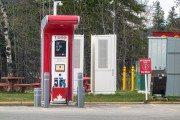For the Wynne government to pass its first budget, it may have to consider some policies demanded by the NDP, including rolling back auto insurance premiums by 15 per cent. While insurance rates are higher in Ontario than in some other provinces, there are better policy solutions to offer drivers a break without undermining other key government priorities — namely reducing congestion in the GTA.
The congestion battle goes beyond building transit. It must include complementary policies like better urban planning and thoughtful “carrots” for commuters to encourage less driving, not an across-the-board subsidy to encourage more.
One such incentive that can reduce costs is “pay as you drive insurance” (PAYD), which charges drivers by the distance they drive. Extensive research has found this to be one of the most effective methods of decreasing vehicle kilometres travelled (the total amount of driving in a given area) and promoting a shift from auto to transit, carpooling or active transportation, and even telecommuting.
The program rewards driving reductions with lower insurance costs, and makes it more cost-effective for drivers to invest in other modes, be it a transit pass, carpooling or a bicycle, by freeing up part of their transportation budget.
In a survey conducted by the Pembina Institute last year, two-thirds of GTA drivers indicated they would likely try “pay as you drive” auto insurance if it were available, and of these, 85 per cent would change their commuting habits to find some other way to get to work if they had PAYD.
In motion elsewhere
PAYD insurance is used in the U.S., Europe and around the world. In the U.S., for example, Progressive Insurance offers optional pay-as-you-drive insurance in 39 states, with an average savings for customers of 10 to 15 per cent. And it’s effective in reducing driving — one U.S. study demonstrated that a charge of $0.06 per kilometre would reduce distances driven by 10 per cent. A Brookings Institution study from 2008 found that under PAYD insurance, driving distances would be reduce by 8 per cent while almost two-thirds of households would pay less for auto insurance — saving an average of $270 US per year.

PAYD insurance is not currently available in Canada, although Aviva Insurance in Ontario offered a pilot program from 2005 to 2010; 6000 Ontarians participated with an average savings of 19 per cent. And while it was introduced primarily as a method of collecting behavioural data such as speed, distance and time of day of driving to assess individual accident risk, a survey by the Insurance Bureau of Canada showed that a permanent program of this type would be favoured by the majority of Ontarians; it would (as expected) be most popular among those who drive less than 10,000 km per year.
A 2008 survey of North American insurers showed that 70 per cent of companies already offer, are considering testing, or are planning to offer PAYD pricing. The survey found the top market driver was competitiveness followed by exercising corporate responsibility with a “green” product. Furthermore, technology available now resolves the privacy concerns of various tracking devices.
Short-term gain for long-term gain
Reducing congestion is one of many benefits to reducing travel distances through PAYD insurance; others include reducing accidents and improving insurance affordability with premiums better reflecting a vehicle’s accident exposure. Currently, mileage is not effectively accounted for when determining insurance rates, aside from the distinction of usage of the vehicle for work or pleasure.
And PAYD insurance would be even more attractive with additional incentives to help commuters spend less time behind the wheel. The same Pembina survey found that 94 per cent of drivers would be interested in telecommuting if offered by their employer, 63 per cent would be likely to trade their employee parking spot for cash and find another way to get to work if a parking cash-out program were available, and over 60 per cent of drivers would consider carpooling if there were an added incentive to do so, such as flexible work hours or a financial incentive.
![*"How likely would you be to take advantage of these options if they were offered?" [(<i>Drivers' Choice,</i> The Pembina Institute, 2012);http://www.pembina.org/pub/2333] Commuter incentives](/images/blogs/full-b/drivers-choice-fig1-commuter-incentives.png)
So while we wait for transit expansion to be built, our political parties should champion a variety of solutions that can provide drivers with options and start to chip away at gridlock now.
Updated 2013-04-30 16:28 ET to add Brookings Institution data.
Follow Cherise on Twitter @CheriseBurda.






